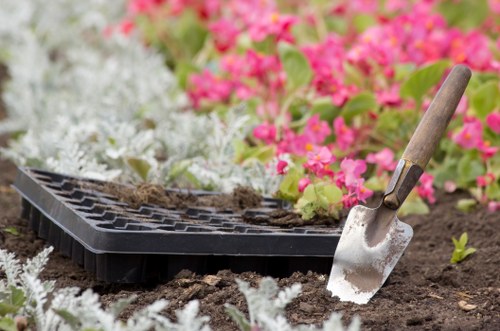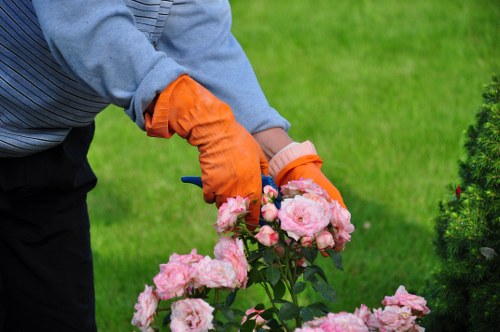Mastering Hedge Trimming in Gardening Services

Hedge trimming is a fundamental aspect of gardening services that not only enhances the aesthetic appeal of a garden but also promotes the health and longevity of hedges. Whether you're a seasoned gardener or a homeowner looking to maintain your outdoor space, understanding the nuances of hedge trimming is essential.
Regular maintenance through professional hedge trimming can prevent overgrowth, reduce the risk of diseases, and ensure that your hedges remain a focal point of your landscape. In this comprehensive guide, we'll delve into the best practices, tools, and benefits of hedge trimming.
From selecting the right time of year to choosing the appropriate trimming techniques, this article provides valuable insights for achieving perfectly manicured hedges.

The Importance of Hedge Trimming
Hedge trimming serves multiple purposes in garden maintenance. Firstly, it helps maintain the desired shape and size of hedges, ensuring they complement the overall garden design. Secondly, regular trimming promotes healthy growth by removing dead or diseased branches, allowing the plant to focus its energy on healthy foliage.
Moreover, well-trimmed hedges can act as effective privacy screens or windbreaks, providing both functional and aesthetic benefits. Neglecting hedge maintenance can lead to unruly growth, increased susceptibility to pests, and a less appealing garden appearance.
Investing time and resources into proper hedge trimming can significantly enhance the value and beauty of your outdoor space.

When to Trim Your Hedges
Timing is crucial when it comes to hedge trimming. The best time to trim most hedges is in late winter or early spring before new growth begins. This period allows plants to recover quickly and encourages robust growth during the growing season.
However, some hedges, especially those that flower, may require pruning after they bloom to avoid removing next year's flower buds. It's essential to understand the specific needs of each hedge type to ensure optimal results.
Additionally, light trimming can be done throughout the growing season to maintain shape and control size, but heavy pruning should be reserved for the dormant season.

Essential Tools for Hedge Trimming
Pruning Shears
Pruning shears are ideal for small hedges and precise cuts. They come in various types, including bypass and anvil shears, each suited for different plant materials.
Hedge Trimmers
For larger hedges, electric or gas-powered hedge trimmers are more efficient. They allow for quick, even trimming and are essential for maintaining uniformity in dense hedges.
Loppers
Loppers are used for thicker branches that pruning shears can't handle. They provide the leverage needed to cut through tougher stems.
Safety Equipment
Always wear protective gear, such as gloves, safety glasses, and long sleeves, to prevent injuries while trimming.

Hedge Trimming Techniques
Employing the right trimming techniques ensures healthy and attractive hedges. Here are some key methods:
- Level Cutting: Make sure all edges are even to create a uniform appearance.
- Top and Side Trimming: Focus on trimming the sides and top to shape the hedge appropriately.
- Thinning: Remove excess branches to improve air circulation and light penetration.
- Rejuvenation Pruning: For overgrown hedges, cut back heavily to stimulate new growth.
Consistent application of these techniques will help maintain the desired form and health of your hedges.
Shaping Hedges
Different garden designs may require various hedge shapes, such as formal, informal, or natural. Use tools like string lines and stakes to guide your trimming and achieve precise shapes.

Benefits of Professional Hedge Trimming Services
While DIY trimming is possible, hiring professional gardening services offers numerous advantages. Professionals bring expertise in identifying plant health issues, using the right tools, and applying appropriate techniques.
They can save you time and effort, ensuring that your hedges are trimmed efficiently and effectively. Additionally, professionals can provide tailored maintenance plans to keep your garden looking its best year-round.
Investing in professional hedge trimming services can enhance the overall appearance and health of your garden, making it a worthwhile consideration for any homeowner.

Choosing the Right Gardening Service
Experience and Expertise
Select a gardening service with a proven track record in hedge trimming. Experienced professionals are more likely to understand the specific needs of different hedge types and apply the best practices.
Customer Reviews and Testimonials
Check reviews and testimonials to gauge the quality of service. Positive feedback from previous clients indicates reliability and satisfaction.
Pricing and Packages
Compare pricing structures and service packages to find one that fits your budget and needs. Some services offer seasonal maintenance plans, which can provide consistent care for your hedges.
Licensing and Insurance
Ensure that the gardening service is licensed and insured to protect against any potential damages or accidents during the trimming process.

Maintaining Trimmed Hedges
After trimming, proper maintenance is essential to keep your hedges healthy and looking their best. Here are some maintenance tips:
- Watering: Ensure your hedges receive adequate water, especially during dry periods.
- Fertilizing: Apply appropriate fertilizers to promote healthy growth.
- Monitoring for Pests: Regularly check for signs of pests or diseases and address them promptly.
- Mulching: Apply mulch around the base to retain moisture and suppress weeds.
Consistent maintenance will extend the results of your hedge trimming and contribute to the overall health of your garden.
Seasonal Care
Adjust your maintenance routine based on the season. In spring and summer, focus on promoting growth, while in autumn and winter, prepare your hedges for dormancy by reducing watering and avoiding heavy pruning.

Common Mistakes to Avoid
Avoid these common hedge trimming mistakes to ensure optimal results:
- Trimming Too Late: Trimming hedges too late in the season can stimulate new growth that may not harden off before winter.
- Overpruning: Removing too much foliage can stress the plant and lead to reduced growth.
- Incorrect Tool Use: Using dull or inappropriate tools can cause damage to the hedges and lead to uneven cuts.
- Ignoring Plant Health: Failing to address underlying health issues can worsen after trimming.
Being mindful of these pitfalls will help you maintain healthy and attractive hedges.
Proper Tool Maintenance
Regularly sharpen and clean your trimming tools to ensure clean cuts and prevent the spread of diseases.

Enhancing Your Garden with Trimmed Hedges
Well-trimmed hedges can significantly enhance the overall aesthetics of your garden. They can define spaces, create privacy, and serve as a backdrop for other plants and garden features.
- Creating Paths: Use hedges to outline garden paths, providing structure and guiding visitors through your garden.
- Framing Garden Features: Frame elements like fountains, statues, or flower beds with neatly trimmed hedges to highlight them.
- Seasonal Color: Incorporate hedges that offer seasonal color variations to keep your garden vibrant throughout the year.
By strategically placing and maintaining your hedges, you can create a harmonious and visually appealing outdoor space.
Integrating with Other Plants
Combine hedges with other plants to add diversity and texture to your garden. Mixed planting can create a more dynamic and inviting environment.

Eco-Friendly Hedge Trimming Practices
Embracing eco-friendly practices in hedge trimming contributes to a sustainable garden. Here are some tips:
- Use Electric Trimmers: Opt for electric hedge trimmers over gas-powered ones to reduce carbon emissions.
- Compost Clippings: Compost the trimmed branches and leaves to create nutrient-rich soil for your garden.
- Water Conservation: Implement efficient watering systems to minimize water usage.
- Choose Native Plants: Select native hedge species that are well-adapted to your local climate and require less maintenance.
Adopting these sustainable practices helps create an environmentally friendly garden that thrives with minimal impact.
Reducing Waste
Minimize waste by properly disposing of or repurposing hedge clippings. Consider using them as mulch or incorporating them into your composting system.

Innovations in Hedge Trimming
The gardening industry continually evolves with new technologies and techniques that make hedge trimming more efficient and effective. Some recent innovations include:
- Battery-Powered Trimmers: Offering greater mobility and reduced noise compared to traditional electric models.
- Robotic Hedge Trimmers: Automated devices that can maintain hedge shapes with minimal human intervention.
- Smart Tools: Hedge trimmers equipped with sensors and smart features to optimize cutting patterns and reduce waste.
Staying informed about these advancements can help you choose the best tools and services for your hedge trimming needs.
Precision Cutting Technologies
New precision cutting technologies ensure more accurate and cleaner cuts, promoting healthier hedge growth and reducing the risk of disease.

Cost Considerations
Understanding the cost factors associated with hedge trimming can help you budget appropriately. Key considerations include:
- Size and Density: Larger and denser hedges require more time and resources to trim.
- Hedge Type: Some hedge species are more challenging to trim and may incur higher service costs.
- Frequency of Trimming: Regular maintenance can prevent the need for more extensive and costly trimming sessions.
- Additional Services: Services like cleaning up debris, applying fertilizers, or pest control may influence the overall cost.
By understanding these factors, you can make informed decisions and choose services that offer the best value for your investment.
Budgeting for Maintenance
Plan a maintenance budget that covers regular trimming, tool maintenance, and any unexpected expenses related to hedge health issues.

DIY Hedge Trimming Tips
If you prefer to trim your hedges yourself, here are some tips to achieve professional-looking results:
- Plan Your Shape: Decide on the desired shape and outline it before starting.
- Use Sharp Tools: Ensure all your tools are sharp for clean cuts.
- Trim Gradually: Make small cuts over several sessions to avoid overpruning.
- Maintain Consistency: Keep your trimming consistent to achieve a balanced and even appearance.
With patience and the right techniques, DIY hedge trimming can be a rewarding aspect of garden maintenance.
Safety First
Always prioritize safety by wearing appropriate gear and maintaining your tools properly to prevent accidents.

Conclusion: The Art of Hedge Trimming
Hedge trimming is both a practical necessity and an art form in gardening services. By understanding the importance, techniques, and best practices, you can maintain beautiful and healthy hedges that enhance your garden's appeal.
Whether you choose to hire professional services or take on the task yourself, investing time in proper hedge trimming will yield long-term benefits for your outdoor space.
Contact us today to schedule your hedge trimming service and transform your garden into a masterpiece.